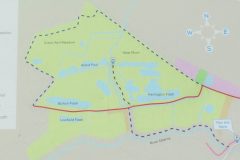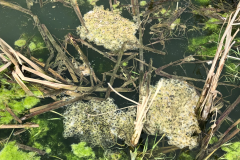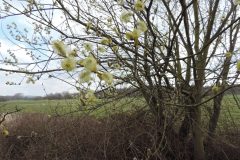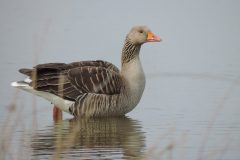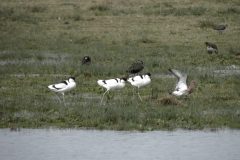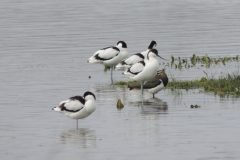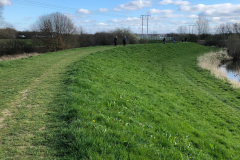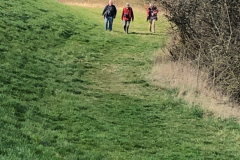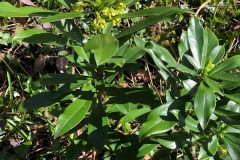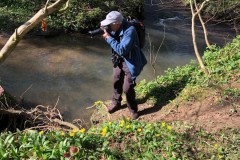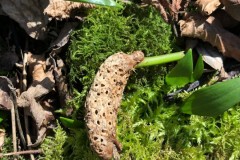Leader : Nora Boyle
Six members present.
The meeting started at the Trans-pennine Trail car park as indicated on the R.S.P.B. map. Almost straight away we heard the familiar song of Chiffchaff, a song we continued to hear as we moved through the reserve and in several situations we were lucky enough to have extremely clear views of birds perching high in the tree tops.
We followed the Trans-pennine Trail until it met the public bridleway, shown on the map in red, heading towards Harlington Flash. Ash buds were just beginning to open revealing the blackberry-like fat buds of the flowers which appear before the leaves. Blackthorn flowers on some bushes were beginning to show signs of decay, petals falling to the ground giving the appearance of plants with tiny white petals but others still appeared as masses of fresh white flowers, as with the ash, appearing before the leaves. Walking along the bridleway we came across a fellow birdwatcher who explained he had been observing a Little Owl flitting in and out of the canopy of a tree in the distance. In order to get a bit closer for the chance of seeing the owl we left the path and walked round the edge of a circular pond shown to the north of the reserve on the R.S.P.B. map. Unfortunately, it wasn’t possible to get much closer but Tim was more interested in the pond and noted that there were several clumps of frogspawn along with water mint with its very distinctive minty smell.
As noted in the previous visit on the 12th March, ground flora was beginning to emerge, in particular Coltsfoot, White Dead-nettle, Arum maculatum and Cocksfoot grass. Tim discovered several examples of Cigar galls formed by a fly called Lipara lucens on Common Reed Phragmites australis.
In the hedgerow were several pussy willows bearing catkins at various stages of development. Willows are dioecious meaning male and female flowers grow on separate trees, the term pussy willows used to refer to both male trees and the furry catkins which appear early in the year and well before the leaves. Some of the willow catkins observed were still tightly closed and covered in covered with tiny silver hairs acting as insulation to protect them from cold temperatures but some, as in figure 3, were fully in bloom and stood out clearly in the blue sky with their masses of yellow pollen.
On leaving the pond we continued along the public bridleway until we reached Harlington Flash. There we could see Canada geese and Greylag geese feeding both in the water and on the surrounding grassland.
Waders such as Lapwing, Redshank and even Little Ringed Plovers were also observed. We spent a fair amount of time watching two species Ruff and Black-tailed Godwit which weren’t on the list for the 12th of March. Avocets with their magnificent black and white plumage and grey-blue legs were feeding in the shallower water near the islands.
After some time, we headed towards the viewing point shown on the R.S.P.B. map and on the way, we observed two Pink- footed geese with their darker heads and as the name suggests, pink legs.
In the trees and shrubs alongside the paths we saw a good number of passerines whose names will appear on Colin’s species list accompanying this report.
From the viewing point we picked up several species which we hadn’t seen on the Flash in particular Little Egret, Shoveller, Wigeon and Common Gull.
At about 3.30pm we returned to the public bridleway, crossed over to the other side and headed back to the car park via the bank of the River Dearne. We left the car park at approximately 4pm.
Nora Boyle
Notes
On arriving back along the flood embankment Tim Kohler drew attention to the large accumulation of tree and shrub debris deposited on the central buttress of the carboniferous sandstone Adwick road bridge. The height of the debris indicated that the floodwater from the February storms [Dudley, Eunice and Franklin] had almost reached the level of the carriageway.
Recording areas:
1 = Trans-pennine car park to Bridleway (SE4702).
2 = Circular Pond to the north of the perimeter path (SE4702).
3 = Lake to north of Lowfield Road bridleway (SE4702).
4 = Hedge & Drains along bridleway & adjacent fields (SE4602).
5 = Causeway to Outlook (SE4602).
6 = Seen from the Outlook (SE4602).
7 = River Dearne Flood Embankment (SE4602)
+ = not counted
| Latin Name | Common Name | 1 | 2 | 3 | 4 | 5 | 6 | 7 |
|---|---|---|---|---|---|---|---|---|
| Flora | ||||||||
| Alisma plantago-aquatica | Water Plantain | * | ||||||
| Anthriscus sylvestris | Cow Parsley | * | * | * | ||||
| Arum maculatum | Arum | * | ||||||
| Betula pendula | Birch | * | * | |||||
| Callitriche stagnalis | Starwort | * | ||||||
| Callitriche stagnalis | Water Starwort | * | ||||||
| Caltha palustris | Kingcups (f) | * | ||||||
| Carex acutiformis | Lesser Pond Sedge | * | ||||||
| Centaurea nigra | Knapweed | * | * | * | ||||
| Corylus avellana | Hazel (catkins) | * | * | |||||
| Crassula helmsii | Newzealand pygmyweed | * | * | |||||
| Dactylis glomerata | Cock’s-foot grass | * | * | * | ||||
| Epilobium hirsutum | Great Willowherb | * | * | |||||
| Ficaria verna | Lesser Celandine (f) | * | * | * | ||||
| Filipendula ulmaria | Meadowsweet | * | * | * | ||||
| Fraxinus excelsior | Ash (f) | * | * | |||||
| Galium aparine | Cleavers | * | * | * | ||||
| Geranium dissectum | Cut-leaved Cranesbill | * | ||||||
| Geranium robertianum | Herb Robert | * | ||||||
| Geum urbanum | Wood Avens | * | ||||||
| Glechoma hederacea | Ground Ivy (f) | * | ||||||
| Glyceria sp. | A flote grass | * | ||||||
| Hedera helix | Ivy | * | ||||||
| Heracleum sphondylium | Hogweed | * | * | * | ||||
| Hypochoeris radicata | Cat’s-ear | * | ||||||
| Ilex aquifolium | Holly | * | * | |||||
| Juncus effuses | Soft Rush | * | ||||||
| Juncus inflexus | Hard Rush | * | ||||||
| Lamium album | White Dead-nettle (f) | * | * | * | ||||
| Lemna minor | Duckweed | * | ||||||
| Lemna minuta ? | Least Duckweed | * | ||||||
| Leucanthemum vulgare | Oxeye Daisy | * | ||||||
| Lonicera periclymenum | Honeysuckle [2 forms] | * | * | |||||
| Mentha aquatica | Water Mint | * | ||||||
| Muscari armeniacum | Grape Hyacinth (f) | * | ||||||
| Phalaris arundinacea | Reed Canarygrass | * | * | |||||
| Phragmites australis | Great Reed | * | * | |||||
| Populus sp. | Poplar sp. (catkins) | * | ||||||
| Potentilla reptans | Creeping Cinquefoil | * | * | |||||
| Prunus spinosa | Blackthorn (f) | * | * | * | ||||
| Pteridium aquilinum | Bracken | * | ||||||
| Quercus robur | Oak | * | * | * | ||||
| Ranunculus sceleratus | Celery-leaved Buttercup | * | ||||||
| Rosa canina | Dog Rose | * | * | * | ||||
| Rubus fruticosus | Bramble | * | * | * | * | |||
| Rumex obtusifolius | Broad-leaved Dock | * | * | * | ||||
| Salix | Sallow | * | * | * | ||||
| Salix sp. | Pussy Willow (f) | * | ||||||
| Sambucus nigra | Elder | * | ||||||
| Scrophularia auriculata | Water Figwort | * | * | * | ||||
| Stellaria media | Chickweed (f) | * | ||||||
| Tanacetum vulgare | Tansey | * | * | * | * | |||
| Taraxacum officinale | Dandelion agg. sp. (f) | * | ||||||
| Tussilago farfara | Coltsfoot (f) | * | ||||||
| Typha latifolia | Reedmace | * | * | |||||
| Ulex europaeus | Gorse (f) | * | * | |||||
| Urtica dioica | Stinging Nettle | * | * | |||||
| Veronica persica | Field Speedwell (f) | * | ||||||
| Birds | 1 | 2 | 3 | 4 | 5 | 6 | 7 | |
| Aegithalos caudatus | Long-tailed Tit | 2 | 2 | |||||
| Alauda arvensis | Skylark (s) | 2 | ||||||
| Anas clypeata | Shoveller | 4 | 2 | |||||
| Anas crecca | Teal | 15 | + | |||||
| Anas penelope | Wigeon | 4 | ||||||
| Anas strepera | Gadwall | 4 | 6 | |||||
| Anas platyrhynchos | Mallard | 4 | 2 | |||||
| Anser anser | Greylag Goose | 89 | + | |||||
| Anser brachyrhynchus | Pink-footed Goose | 3 | ||||||
| Athene noctua | Little Owl (not seen by our group) | * | ||||||
| Branta canadensis | Canada Goose | 17 | + | |||||
| Charadrius hiaticula | Ringed Plover | 2 | ||||||
| Chloris chloris | Greenfinch | 1 | ||||||
| Chroicocephalus ridibundus | Blackheaded Gull | + | 43 | |||||
| Columba palumbus | Wood Pigeon | * | ||||||
| Corvus corone | Carrion Crow | * | 2 | 2 | ||||
| Corvus frugilegus | Rook (injured) | 1 | 6 | |||||
| Corvus monedula | Jackdaw | |||||||
| Dendrocopos major | Great spotted Woodpecker | 1 | ||||||
| Egretta garzetta | Little Egret | 1 | ||||||
| Emberiza schoeniclus | Reed Bunting | * | 1 | 1 | ||||
| Erithacus rubecula | Robin (s) | * | ||||||
| Falco tinnunculus. | Kestrel | * | ||||||
| Fulica atra | Coot | 6 | + | |||||
| Gallinula chloropus | Moorhen | 4 | ||||||
| Haematopus ostralegus | Oystercatcher | * | 4 | |||||
| Larus argentatus | Herring Gull | 1 | ||||||
| Larus canus | Common Gull | 1 | ||||||
| Limosa limosa | Black-tailed Godwit | 1 | ||||||
| Parus major | Great Tit (s) | * | 2 | 2 | ||||
| Phasianus colchicus | Pheasant | 3 | ||||||
| Philomachus pugnax | Ruff | 1 | ||||||
| Phylloscopus collybita | Chiffchaff | * | 1 | 1 | ||||
| Pica pica | Magpie | 2 | 2 | |||||
| Prunella modularis | Dunnock | * | ||||||
| Recurvirostra avosetta | Avocett | 17 | ||||||
| Tadorna tadorna | Shelduck | 2 | ||||||
| Tringa totanus | Redshank (calling and displaying) | 4 | + | |||||
| Troglodytes troglodytes | Wren (s) | * | ||||||
| Turdus merula | Blackbird (s) | * | ||||||
| Turdus philomelos | Song Thrush (s) | * | ||||||
| Vanellus vanellus | Lapwing | 25 | + | |||||
| HERPTILES | Frogspawn (5 clumps) | * | ||||||
| The flote grass looked ideal for newt egg deposition | ||||||||
| INVERTEBRATES | ||||||||
| Polygonia c-album | Comma butterfly | * | * | * | ||||
| Bombus lapidarius | Red-tailed Bumble bee | * | * | * | * | |||
| 1 | 2 | 3 | 4 | 5 | 6 | 7 | ||
Leader : Colin Howes
Leader : John Scott & Louise Hill
16 members and friends present.
A bright sunny day, the Butterflies were becoming active with sightings of Brimstones punctuated by Commas (!)
| Botanical Name | Vernacular Name | SK5489 | SK5490 | SK5390 |
|---|---|---|---|---|
| Acer pseudoplatanus | Sycamore | * | * | * |
| Alliaria petiolata | Jack-by-the-hedge | * | * | * |
| Allium ursinum | Wild Garlic | * | * | * |
| Alnus glutinosa | Alder | * | * | * |
| Anemone nemorosa | Wood Anenomy (in Flower) | * | * | |
| Angelica sylvestris | Wild Angelica | * | * | * |
| Anthriscus sylvestris | Cow Parsley | * | * | * |
| Arctium minus | Lesser Burdock | * | * | * |
| Arum maculatum | Arum | * | * | * |
| Asplenium ruta-muraria | Wall Rue (on Abbey gatehouse) | * | ||
| Asplenium scolopendrium | Hart’s-tongue Fern | * | * | |
| Bellis perennis | Daisy (in Flower) | * | * | * |
| Betula pendula | Silver Birch | * | * | * |
| Brachypodium sylvaticum | False Brome | * | * | * |
| Buddleja davidii | Butterfly Bush | * | ||
| Centaurea nigra | Common Knapweed | * | * | * |
| Cirsium arvense | Creeping Thistle | * | * | * |
| Clematis vitalba | Traveller’s Joy | * | * | |
| Conopodium majus | Pignut | * | ||
| Cornus sanguinea | Dogwood | * | * | * |
| Corylus avellana | Hazel (males in Flower) | * | * | * |
| Crataegus monogyna | Hawthorn | * | * | * |
| Dactylis glomerata | Cock’s-foot | * | * | * |
| Daphne laureola | Spurge Laurel (in Flower) | * | * | |
| Dryopteris dilitata | Broad Buckler Fern | * | * | |
| Fagus sylaticus | Beech | * | * | * |
| Ficaria verna | Lesser Celandine (in Flower) | * | * | * |
| Filipendula ulmaria | Meadowsweet | * | * | |
| Fraxinus excelsior | Ash | * | * | * |
| Galanthus nivalis | Snowdrop (mainly finished flowering) | * | ||
| Galium aparine | Cleavers | * | * | * |
| Geranium robertianum | Herb Robert | * | * | * |
| Glechoma hederacea | Ground Ivy (in Flower) | * | * | * |
| Hedera helix | Ivy | * | * | * |
| Helleborus viridis | Green Helebore (in Flower) | * | ||
| Heracleum sphondylium | Hogweed | * | * | * |
| Hyacinthoides non-scripta | Bluebell | * | * | * |
| Hypericum androsaemum | Tutsan | * | ||
| Ilex aquifolium | Holly | * | * | * |
| Lamium album | White Dead Nettle (in Flower) | * | * | * |
| Ligustrum vulgare | Wild Privet | * | * | * |
| Lonicera periclymenum | Honeysuckle | * | * | * |
| Mahonia aquifolium | Oregon Grape (in Flower) | * | * | |
| Mercurialis perennis | Dog’s Mercury (in Flower) | * | * | * |
| Narcissus pseudonarcissus. | Wild Daffodil (in Flower) | * | * | * |
| Phyllitis scolopendrium | Hart’s–tongue Fern | * | * | * |
| Polystichum setiferum | Soft Shield Fern | * | * | |
| Primula vulgaris | Primrose (in Flower) | * | * | * |
| Prunus spinosa | Blackthorn (in Flower) | * | * | * |
| Pteridium aquilinum | Bracken | * | * | * |
| Quercus robur | Pedunculate Oak | * | * | * |
| Ranunculus repens | Creeping Buttercup | * | * | * |
| Rosa campestris | Field Rose | * | ||
| Rosa canina | Dog Rose | * | * | * |
| Rubus fruticosus | Bramble | * | * | * |
| Rumex obtusifolius | Broad Dock | * | * | * |
| Salix spp | Pussy Willow spp (in flower) | * | ||
| Sambucus nigra | Elder | * | * | * |
| Sanicula europaea | Sanicle | * | * | |
| Taxus baccata | Yew (in Flower) | * | * | * |
| Tilia cordata | Small-leaved Lime | * | * | |
| Ulmus glabra | Wych Elm (in Flower) | * | * | |
| Urtica dioica | Stinging Nettle | * | * | * |
| Veronica persica | Field Speedwell | * | * | |
| Viola odorata | Sweet Violet (in flower – white form) | * | * | |
| Viola riviniana | Common Dog Violet | * | * | |
| DIPTERA | ||||
| Eristalis tenax | Dronefly | * | ||
| HYMENOPTERA | ||||
| Apis mellifera | Honey Bee (nectaring on Ficaria verna) | * | ||
| LEAF MINERS | ||||
| Diptera: Agromyzidae | ||||
| Phytomyza ilicis | Holly Leaf-miner Blotch Miner on Holly |
* | * | |
| Lepidoptera: Nepticulidae | ||||
| Stigmella aurella | Golden Pigmy Leaf Miner on Bramble |
* | * | |
| Stigmella splendidissimella | Glossy Bramble Pigmy Leaf Miner on Bramble |
* | * | |
| LEPIDOPTERA (Butterflies) | ||||
| Gonepteryx rhamni | Brimstone Butterfly (4) | * | * | * |
| Vanessa atalanta | Red Admiral (seen by Joyce) | * | ||
| Polygonia c-album | Comma (3) | * | * | * |
| BIRDS | ||||
| Blackbird | * | * | * | |
| Blue Tit (Calling) | * | * | ||
| Buzzard (Calling) | * | * | * | |
| Carrion Crow | * | * | * | |
| Chaffinch (singing) | * | * | * | |
| Chiffchaff (Singing) | * | * | * | |
| Dunnock (Singing) | * | * | * | |
| Great Spotted Woodpecker (Calling & drumming) | * | * | ||
| Great Tit (Calling) | * | * | * | |
| Jackdaw | * | * | * | |
| Jay | * | |||
| Long-tailed Tit | * | |||
| Magpie | * | * | * | |
| Mallard | * | * | ||
| Nuthatch (singing) | * | * | ||
| Pheasant (Calling) | * | * | ||
| Robin (Singing) | * | * | * | |
| Song Thrush (Singing) | * | * | * | |
| Wood Pigeon | * | * | * | |
| Wren (Singing) | * | * | * | |
| MAMMALS | ||||
| Mole (hills) | * | * | * | |
| Roe Deer (Foot prints) | * | |||
| Badger (Footprints) | * | |||
| Fox (Scent) | * | * | ||
| Rabbit (seen by Paul) | * | |||
| Brown Hare (seen by Jim) | * | |||
Recorder CAH.
Preliminary visit to Adwick on Dearne RSPB Washland Nature Reserve.
Aims: To work out routes and timing for the Nats visit scheduled for Sunday 27 March 2022 looking for birds and other wildlife on the water meadows and marshes.
Background information: Edited from notebook entries and RSPB website –
- The strategic function of Environment Agency Washlands along river catchments is to manage excess water from flooding events, storing it ‘out of harm’s way’ and thus prevent homes and businesses from flooding.
- With a view to enhancing the biodiversity potential of this policy within the in the Dearne river catchment, in 2011 the RSPB took the lease on a large area of land from the Environment Agency to create the RSPB Adwick Washland. This brings the number of sites the RSPB manages in the Dearne Valley to seven.
- Adwick Washland is about 95 football pitches in size, is pretty flat and is drained by a network of ditches and pumps that lift excess water into the embanked River Dearne. The area has a history of drift mining but after the removal of coal deposits the land was returned to agricultural use and was farmed until the RSPB took it on.
- Adwick Washland is situated between the villages of Bolton on Dearne, Harlington and Adwick on Dearne. A bridleway (Lowfield Road) runs east/west through the site and there is a car park on the Transpennine Trail at the eastern (Adwick on Dearne) end and at the western end is Bolton on Dearne railway station. This gives good access to the site and a circular walk can be had by linking with the River Dearne flood bank.
- A path from midway along the Lowfield Road bridleway leads north to a slightly elevated lookout point bounded by a three-sided drystone wall structure created from re-used carboniferous sandstone blocks. This stout structure (the Look-out) forms the centre point of the site and affords views over the reserve and of the surrounding villages of Bolton on Dearne, Goldthorpe, Hickleton, Barnburgh, Harlington, Adwick on Dearne and Mexbrough … try picking out the parish churches.
- The Look-out resembles a 19th century shooting butt from a Pennine grouse moor but instead of the walls being the right height to rest your shot gun on, it’s the right height to rest your binoculars on. Looking towards Bolton on Dearne, undulations in the fields identified ‘Ridge and Furrow’ management indication the survival of an ancient agricultural landscape.
- The main function of Adwick Washland as a nature reserve is to create wet grassland to help breeding waders such as Snipe, Lapwing and Redshank. Sluices installed by the Environment Agency manage water levels to just below land surface. Scrapes and ditches have been excavated so that water bodies are available throughout the year. This combination of wet grassland and open water enables the chicks of wetland species to find their preferred invertebrate foods. The drier areas are being managed to encourage such farmland birds as Yellowhammer and Skylark.
Date: 12 March 2022
Present: Nora Boyle & Colin Howes
Arrived at Transpennine Trail Car Park at 12:45 … departed 3.20pm. (2 hrs 35 minutes)
Abbreviations (sp) = species; (s) = singing; (ca) = calling;(d) = displaying; (c) = catkins; (f) = flowering; (pr) = pair.
Followed footpath to the reserve perimeter path and on to Lowfield Road bridleway.
Ground flora included Cleavers; Nettle; White Dead-nettle (f); Herb Robert; Hogweed; Cow Parsley; Cock’s-foot grass; Arum maculatum; Bracken.
Shrub layer contained Blackthorn (f) Birch; Hazel (c).
Birds – Blackbird; Dunnock; Robin; Wren (s).
A circular pond to the north of the perimeter path looked ideal for amphibians. (Perimeter path too muddy to negotiate).
Lake to north of Lowfield Road bridleway
Redshank 4+ (ca & d)
Lapwing 11 +
Avocet 11 +
Oystercatcher 2
Black-headed Gull 53+
Shoveler 1
Teal 8+
Gadwall 2
Greylag Goose 150+
Canada goose 6+
Drain adjacent to bridleway
Mute swan pair feeding on Duckweed Lemna minor.
2nd lake to north of Lowfield Road bridleway
Lapwing 61+
Coot 5+
Moorhen 4 +
Black-headed Gull 100 +
Common Gull 2
Lesser Black-backed Gull 1
Herring Gull 4
Shoveler 2
Wigeon 2pr
Shelduck 1 pr.
Hedge along bridleway
Since this roadway features on the 1st edition 1 inch to 1 mile Ordnance Survey map, surveyed between 1838 and 1840, the shrubs and trees by the path are probably the survivals of an old pre-enclosure hedgerow. Species noted include Gorse (f); Ash; Honeysuckle sp.; Rose (sp); Blackthorn; Holly; Hazel (coppiced); Sallow sp.
Long-tailed Tit 3 +
Seen from Outlook
Gadwall 3 pr.
Starling 11+ 20
Greylag Goose many including 1 Pink-footed Goose
Redshank
Common Gull 2
Lesser Black-backed Gull 3
Herring Gull 3
Immature large gulls 6
Wigeon 8
Teal not counted
Mallard 4
Walked from Outlook back to Transpennine Trail car park via the river Dearne flood embankment 3pm to 3.20pm (20 minutes).
Leader : Mick Townsend.
